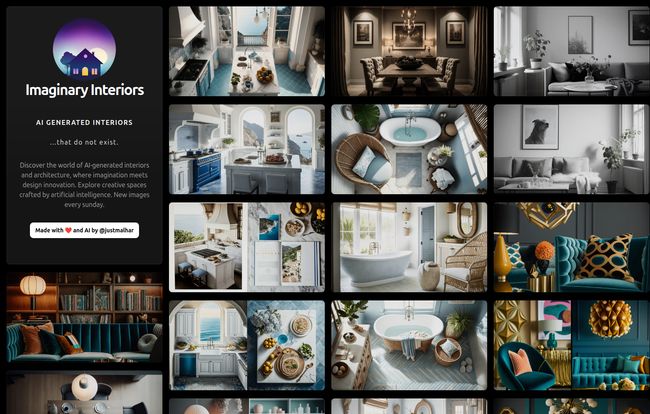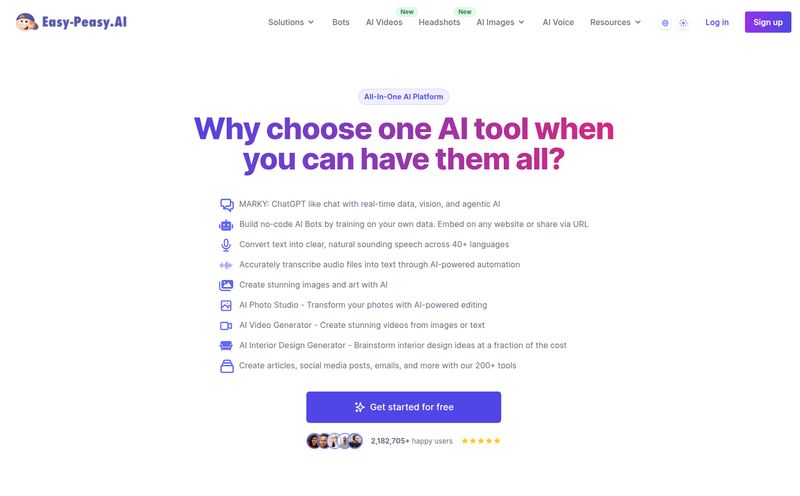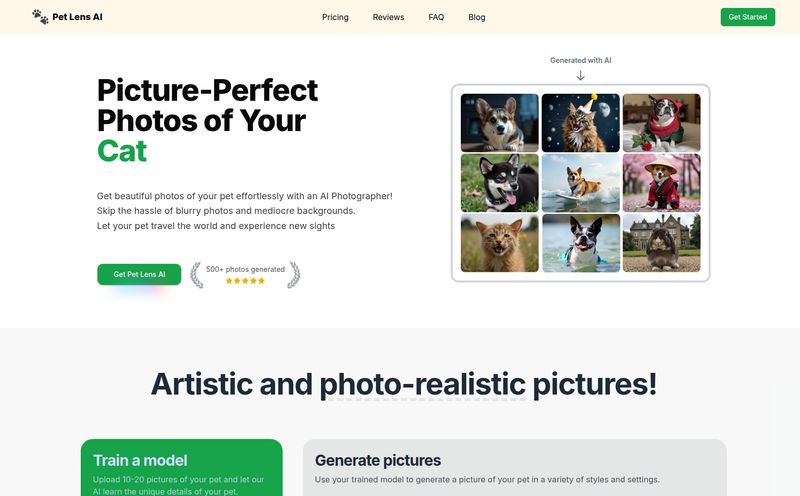You know that feeling? You’re staring at a room in your house—for me, it was the sad, beige home office—and you just feel… nothing. Blank. The creative well is dry. You’ve scrolled through Pinterest until your thumb is numb, and every beige-and-white minimalist living room has started to blend into one giant, soulless blob. I was there. Deep, deep in a design rut.
Then, while clicking through the usual SEO and tech forums, I stumbled on a little project called Imaginary Interiors. The tagline was simple: “AI-generated interior design inspiration.” My curiosity, as a guy who spends way too much time thinking about algorithms and trends, was officially piqued. So I clicked. And for the next two hours, I was completely lost in a world of impossible, beautiful, and sometimes downright weird living spaces.
But is it actually useful? Or is it just another shiny AI toy? Let’s talk about it.
So, What Exactly is Imaginary Interiors?
First things first, let's clear up what this platform is and what it isn't. Imaginary Interiors is not a tool where you upload a photo of your messy bedroom and it magically spits out a redesign. It’s not interactive. It's more like a digital art gallery or a high-concept coffee table book that never ends. It's a project by a creator named @justmalhar, who, according to the site, creates and uploads a new batch of AI-generated designs every single Sunday. It’s made with, and I quote, “❤️ and AI.”

Visit Imaginary Interiors
Think of it as a pure inspiration feed. It’s a showcase of what current image generation technology can dream up when you prompt it with ideas about architecture and interior design. And honestly, it’s pretty spectacular to look at. You get everything from cozy, sunken living rooms that look like they're from a 70s Bond villain's lair to hyper-modernist kitchens that defy physics. It’s a Pinterest board on a whole different level.
The Good Stuff: Why You'll Lose Hours Scrolling
The biggest draw here is the sheer, unadulterated creativity on display. AI doesn't care about building codes or budgets. It just creates. This leads to some truly breathtaking concepts that can jolt you out of your design comfort zone. I found myself saving images not because I wanted to replicate the whole room, but because of a single element—a unique color combination, a wild lighting fixture, or a strange way of mixing textures.
Here’s a quick rundown of what I genuinely loved:
| Feature | My Take |
|---|---|
| Endless Inspiration | The variety is stunning. You get rustic, futuristic, minimalist, and maximalist all in one place. It’s a fantastic cure for creative block. |
| Completely Free Downloads | This is huge. You can download any image you like for free. This is perfect for creating personal mood boards or vision boards for your projects. |
| Weekly Content Drops | Knowing there’s something new every Sunday gives you a reason to keep coming back. It’s not a stagnant gallery; its a living collection. |
The platform acts as a fantastic muse. It's like having a brainstorming partner who has seen every design magazine ever published and isn't afraid to mash up ideas in ways a human might not. It pushes you to ask “what if?” about your own space.
Let's Get Real: The AI's Quirks and Limitations
Okay, let's not get carried away. As with any AI image generator, things can get a little… weird. I’ve spent enough time with tools like Midjourney to recognize the tell-tale signs of an AI getting confused. You’ll see chairs with an extra leg, bookshelves that merge into the wall in a way that makes no structural sense, or windows that seem to look out onto another, slightly different, room.
These are not blueprints. They are dreams. And sometimes dreams are nonsensical. This is probably the biggest 'con.' If you’re looking for practical, buildable plans, this isn’t the place. It's a launchpad for ideas, not the final destination.
Another thing for the tech folks out there: the site doesn't specify which AI model it's using. Is it a fine-tuned Stable Diffusion model? Is it Midjourney? A custom-built GAN? As someone who follows the space, I’m always curious about the “how.” This lack of transparency isn’t a dealbreaker for the average user, but it leaves a question mark for enthusiasts.
Is This a Tool for Professionals or Dreamers?
So who is this actually for? I think it sits in a really interesting middle ground.
For the DIY home decorator (like me, staring at my beige office), it's a goldmine. You can grab a dozen images, pull them into Canva, and create a mood board that perfectly captures the vibe you're after. You're not copying the room, you're capturing its essence—the color palette, the mood, the materials.
For a professional interior designer, it’s probably not going to replace their expensive software. But I could see it being a fantastic tool in the initial client meeting. Instead of just asking a client what they like, you could scroll through this gallery together to find a visual language. It’s a great conversation starter to kickstart a project.
"Don't look for a floor plan in these images. Look for a feeling. That's where the real value is."
And for content creators and bloggers, it's a source of high-quality, interesting images for articles or social media posts about design. Just be cool and give credit where it's due, of course.
How to Get the Most Out of Imaginary Interiors
If you go in with the right mindset, this tool is brilliant. Here’s my advice:
- Be a Vibe Hunter: Don't get hung up on the impossible physics. Focus on the overall mood. What emotions does the space evoke? Is it calm, energetic, cozy, or dramatic? That's the thing you want to replicate.
- Deconstruct, Don't Copy: Pick an image you love and break it down. What are the 3-4 key colors? What textures are at play (wood, metal, velvet, concrete)? What kind of lighting is used? You can absolutely find real-world equivalents for these individual elements.
- Build a Mood Board: Use the free downloads! Create a board in your favorite app. Add an image from Imaginary Interiors, then find real-world furniture, paint swatches, and decor items that fit the aesthetic. This bridges the gap between AI dream and real-world possibility.
Let's Talk About the Price Tag
This section is easy. It's free. Zero. Zilch. Nada.
There's no pricing page, no premium subscription, no hidden fees. It seems to be a genuine passion project. In a world where every new AI tool seems to have a complicated credit system or a three-tiered subscription model, this is refreshingly simple. It’s just there for people to enjoy and get inspired by, and I think that’s pretty cool.
The Bigger Picture: AI's March into Creative Fields
Imaginary Interiors is a perfect little microcosm of the larger conversation happening around AI and creativity. Is AI going to replace human designers? I really don't think so. A tool like this doesn't understand a client's needs, a family's lifestyle, or the flow of a physical space. It doesn't have taste; it has data.
What it can do is augment human creativity. It can break us out of our ruts and show us possibilities we hadn't considered. As a writer, I sometimes use AI to brainstorm blog post titles or rephrase a clunky sentence. It doesn’t do the writing for me, but it can be a helpful creative partner. I see tools like Imaginary Interiors in the same light. It’s a collaborator, a muse in the machine. Publications like Architectural Digest have been covering this trend, and the consensus seems to be that AI is becoming another tool in the designer's kit, not a replacement for the designer.
My Final Thoughts on Imaginary Interiors
So, is it just pretty eye candy? Yes. But it’s also a genuinely useful springboard for creativity. I went in looking for a solution to my beige office and came out with a folder full of ideas for textures and colors I’d never have put together on my own. It’s a fun, free, and beautiful resource. Don’t expect it to design your house for you. Expect it to help you dream up a better design for your house. And in my book, that’s a win.
Your Questions Answered
Can I use Imaginary Interiors to redesign my own room?
Not directly. It's a gallery for inspiration, not an interactive tool. You can't upload your own photos. You should use the images to get ideas for colors, styles, and moods that you can then apply to your own space.
Are the images on Imaginary Interiors free to use?
Yes, the website offers a free download gallery. It's great for personal use like creating mood boards. If you're using them for public content, it's always good practice to credit the source, Imaginary Interiors.
How is this different from Pinterest?
While both are for visual discovery, Imaginary Interiors features exclusively AI-generated images that are often more conceptual and fantastical. Pinterest is a collection of real-world photos and products curated by users. Think of Imaginary Interiors as the surreal art gallery and Pinterest as the home goods catalog.
What AI is used to create the designs?
The website doesn't specify the exact AI model or technology used. It's the creator's “secret sauce.”
How often is the website updated?
New AI-generated images are added every Sunday, so there's always fresh inspiration to check out.
Is there a paid version with more features?
No, as of now, Imaginary Interiors is completely free. There is no paid tier or subscription service mentioned on the site.
Reference and Sources
The tool's official website: ImaginaryInteriors.ai
The creator's X (Twitter) profile: @justmalhar
Architectural Digest article on AI in design: “Are We Entering the Age of A.I. Design?”



